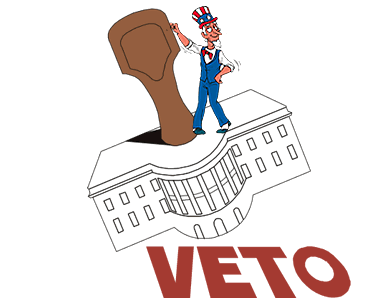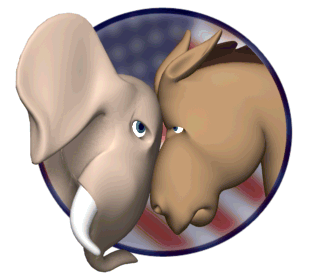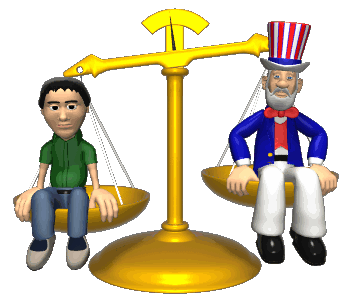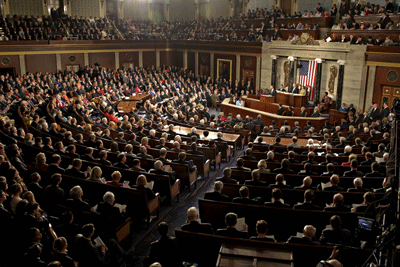
Mr. Dostert's Domain





The House of Representatives
Article I of the Constitution creates a bicameral legislature with the House of Representatives as the lower house. Unlike the Senate the House of Representatives is a body whose representation is based on population. This means that the House of Representatives is more democratic than the Senate. Although the House is considered the lower house of Congress its role is just as important as its job is to represent the people of the United States by creating laws and policy that best serves them.

Membership of the House
The Constitution designed the House to be the voice of the people. Their two-year terms are shorter than their counterparts in the Senate, and with 435 members, the House has far more members than the 100 member Senate. States are awarded representatives based on population which means larger states are given more representatives than smaller states, however every state is guaranteed at least one seat, no matter how small its population is.
The qualifications for the House is set in the Constitution. Representatives must be at least 25 years old, be citizens of the United States for at least 7 years, and be legal residents of the state which elects them.
In order to assign representatives on the basis of population, the Census Bureau takes a national census, or population count, every 10 years. Each state's population determines the number of representatives it will have for the next 10 years- a process called reapportionment. States with slow growth or a population decline can lose representatives, while states with strong population growth can gain seats. O


After states find out how many representatives they will have, their state legislature is responsible for drawing the boundaries for the congressional districts for each representative which they will represent. State legislatures have abused this power to redistrict their state by gerrymandering, or drawing the districts in ways which benefit the political party in power. Gerrymandering is done in two ways- clustering areas with voters likely to vote against them into a single district, or spreading their votes across several districts. The Supreme Court has ruled that congressional districts must be compact and contiguous, or physically adjoining. This has limited gerrymandering, however the competitive struggle between Republicans and Democrats continues to fuel the practice and many districts have irregular shapes simply for political reasons.
Lawmaking in the House
The main task of Congress is to make laws. Unlike its counterpart, the House of Representatives has complex rules based on precedents and past rulings which guide its business. House rules are generally aimed at defining the actions an individual representative can take, such as limiting representatives to how long they can speak. These strict rules are put in place because the House of Representatives has 435 members, far too many to speak on any one issue. If it were not for these rules, legislation would get bogged down in debate and very little would ever get passed.

Because of the size of the House, most work is done in committee. Members are assigned to standing committees which study and investigate bills and decide which are urgent or important enough to send to the floor for the entire House to discuss and debate. These committees like all of congress are controlled by the majority party This means that bills which are sent to the floor are almost always those proposed and favored by the party in power. The minority party mostly fulfills the role as the "voice of opposition" to delay or block bills which they are against.
House Leadership
Leaders of the House coordinate the work of this large body of 435 individual members. It's helpful to think of the work of the leadership as meeting six kinds of goals:
1. Organize and unify party members
2. Scheduling work
3. Making certain that lawmakers are present for key votes
4. Distribute and collect information
5. Keeping the House in touch with the president
6. Influencing lawmakers to support their party's positions


The leader of the House of Representatives is called the Speaker of the House. He/She is the leader chosen by the majority party in the House. The Speaker presides over the House which gives him the power to influence the debate and proceedings by deciding which members to recognize first. The Speaker also appoints the members of some committees, schedules bills for action, and refers bills to the proper House committee. Finally, the Speaker of the House follows the Vice President in the line of succession to the presidency. Today, Speakers rely as much on persuasion as on their formal powers to influence other members.


The Speakers top assistant is the majority leader. The majority leader's job is to help lan the party's legislative program, steer important bills through the House, and make sure the chair-persons finish work on important bills. To aid the majority leader the party choses a whip which oversees how majority-party members intend to vote on bills and works to persuade them to vote as the party wishes. Like the Speaker, the majority leader and whip is elected by the majority party. Thus, the majority leader is not a House official but rather a party official. The minority party also elects its own leaders which parallel the duties of the majority party, except that they do not have the power to schedule work in the House. They often negotiate compromises which may be necessary to pass a bill by attaching things that they support from their agenda to the bills passed by the majority-party.
Elections
Members of the House of Representatives are elected to 2 year terms. These shorter terms are designed to make the House the voice of the people and very responsive to popular opinion. Members of the House must listen carefully to their constituents and act quickly or they may be voted out of office in just two short years.

These two-year terms also mean that there will be an election of members of the House between Presidential elections. These Off-Year (midterm) elections often carry serious political consequences. In most off-year elections the party of the President does poorly. This occurs because most citizens use off-year elections as an appraisal of the president which allows them to voice their frustration with his administration at the polls by voting for the opposition party to the President.

Congress
The Legislative Branch sometimes called congress is the branch of the government where most of the dirty work of governance is done. It is responsible for writing laws of our country. The Legislative branch is a bicameral body meaning that it is made up of two distinct and different groups, the House of Representatives and the Senate. The meet in Washington D.C. in the Capitol Building. Because Congress has the most members and is the most diverse branch of government, it is often the most complicated and difficult because lawmaking requires compromise which politicians are not always willing to do.

The Legislative Branch

Political Parties
Although Political Parties were never mentioned in the Constitution, they have become a necessary component of our form of democracy. The two predominant parties in the United States are the Democratic and Republican parties.
Political Parties serve several functions in our government:
1. Nomination Process*
2. Unite like-minded individuals
3. Inform voters on issues
4. Coordinate Governing
5. Monitor the opposing party


The Two-Party System
Despite these functions, the two-party system has many inherent flaws that can be seen in our government. The first is the apparent lack of options. Because we only have two major parties many view elections as picking which candidate they dislike the least. Secondly, the two-party system encourages political deadlock because neither side is encouraged to compromise because their constituents often voted for them to oppose the other party and compromise could cause them to lose their seat in the next election. In these situations very little can be accomplished which further frustrates the people.


For the most part the two-party system has dominated American politics. Despite this, minor parties do appear in American politics and have influenced the direction of the government on many occasions. Generally speaking there are four types of third parties (minor parties) in the United States:
Third Parties
-
Ideological Parties
-
Economic Protest Parties
Although most Americans do not support minor parties, they have played an important roles in politics including the spoiler role by pulling votes away from a major party's candidate which allows another candidate to win. The threat of running as a third party candidate therefore often forces the major parties to respond to issues of special interests in order to hold a party together.



The National Legislature
Article I of the Constitution establishes a bicameral legislature- one that is made up of two houses. Its job is to transform public will into public policy through the creation of law, but this is often easier said than done. Lawmaking is a complex and often complicated process of balancing the needs of constituents, special interests, and the political party. In this section we will look at the design of the legislative branch and its basic operations.

Two Houses of Congress
As discussed in Unit 1, the United States legislature is a bicameral system- one made up of two separate and distinct bodies. The Senate is considered the upper house because it has fewer members with longer terms, allowing them to exercise considerably more power than their counterparts in the House of Representatives. Each is designed and acts in differently, but legislation requires each different model to agree.

Terms and Sessions
The bicameral system laid out in Article I of the Constitution was a compromise between the larger states and the smaller states and that compromise still plays out in how they act. The Senate was designed to represent the States equally and therefore each state has equal representation with two senators. Because there are 50 states that means that there are 100 senators in total. Senators serve for six-year terms, the longest of any federally elected position, and are therefore expected to be a more enlightened body that should rise above the passions of popular opinion to make decisions which will benefit the country the most. On the other hand the House of Represenatives was designed to represent the people of the states and therefore representation is distributed according to the number of citizens in each state. Once the number of congressmen of a state is determined the state legislatures divide the state into the number of districts given to the state in a process known as reapportionment (we will look more at this when we discuss the House specifically). These representatives will be given two-year terms and therefore are required to constantly maintain popular opinion because every other year they must be reelected by their constitutency.


The Members of Congress

In total there are 535 members of Congress which represent the diverse people of the United States. Their backgrounds are very diverse, however they often do not reflect the ethnic and social class they represent. The question that is often asked is how well does congress truly represent the people if most of the members are White Protestant Men?











The Senate
The upper house of Congress created by Article One of the Constitution is called the Senate. The Constitution gives each state equal representation with two Senators per state. Whereas the House of Representatives struggles to address the demands of its 435 members, the Senate only has 100 which gives it a much more relaxed environment. The Senate is considered a more prestigious position and its members are considered to be wiser and more knowledgeable than their counterparts in the House of Representatives. This means that the senate is much slower and deliberate as well. This slower pace allows issues to be discussed at great length by the Senate as they study and debate bills that address the needs of the people.

Membership of the Senate
The Constitution designed the House to be the voice of the states, because of this originally the Constitution therefore had the State Legislatures choose members to the Senate. This changed following the seventeenth amendment which made senators elected by a statewide general election. Because senators are elected by the entire state rather than districts, this makes their constituency much larger and diverse than their counterparts in the House of Representatives.


The qualifications for the Senate is set in the Constitution. Senators must be at least 30 years old, be citizens of the United States for at least 9 years, and be legal residents of the state which elects them. These are slightly higher standards than the House of Representatives.
The Constitution grants each state two senators who serve for six-year terms, much longer than members of the House. This is done to allow Senators to feel more freedom to deliberate and make choices that may not be popular in their home state. Moreover, unlike the House where the entire body is up for election every two years, the Senate has alternating elections which means that 1/3 of the Senate is elected every two years. This means that the Senate is a continuous body, one who has experienced members at all times and does not ever truly expire.
Lawmaking in the Senate
Although the constitution grants the Senate more responsibilities than the House, its primary job is the same as the House; to make laws. Unlike its counterpart, the Senate has few rules to guide its business. This is to allow the fullest debate and analysis of bills as possible to prevent bad bills from becoming laws. Senators are free to speak on most issues as long as they would like. In certain instances this privilege is abused in what is called a filibuster. Filibusters are an attempt to talk a bill to death. It is a stalling tactic which members of the minority party use to prevent a vote in hopes that the Senate will either reconsider the bill or simply adjourn before a vote can occur, killing the bill. Filibusters are controversial because they are very rarely successful and can hold up important legislation, however they also demonstrate American democracy at its best with one person using their freedom of speech to stand up against what they view as injustice and be heard.

Although much more of the lawmaking process is done on the floor of the Senate than in the House, to streamline the lawmaking process the Senate also does some of its work in committees. Once again, these committees like all of congress are controlled by the majority party This means that bills which are sent to the floor are almost always those proposed and favored by the party in power.
Senate Leadership
Leaders of the Senate coordinate the work of this smaller body of 100 individual members. The biggest difference in the Senate leadership than leadership in the House is that the Senate does not choose its own presiding officer. There is no Speaker in the Senate. Instead, the vice president presides but cannot vote except o break a tie. The V.P. cannot participate in the debate, he simply is recognizes which member occupies the floor and maintains order in the Senate. Most vice presidents find Senate duties unchallenging and devote more time to executive duties. In the absence of the V.P., the President Pro Tempore presides. The Senate elects this leader from the majority party. Usually, it is that party's longest-serving member.



The Senate's most important officers are the majority and minority leaders. Elected by party members, these are officials of the party, not of the Senate. The job of the majority leader is to steer the party's bills through the Senate, which is done by planning the work schedule and agenda in consultation with the minority leader. The majority leader also makes sure that party members attend important sessions and gets support for key bills.
The minority leader has a different job- critiquing the majority party's bills and keeping his or her own party united. As in the House, whips and assistants do the detailed work that supports leaders.













How a Bill Becomes Law
The most basic and essential role of Congress involves its function as the body that crafts, debates, and establishes public policies by writing legislation or laws. The framers of the Constitution made this process a difficult one in order to limit each house of Congress as a check, as well as to prevent bad legislation from reaching the people. This means that the vast majority of bills fail. In fact, in any two year session of Congress ten-thousand or more bills are introduced, but only 4 percent actually are passed to become laws. Let's take a look at the process of how bills become laws.

Introduction of a Bill




Bills can be introduced in either house of Congress. Members of Congress get ideas for bills from a variety of sources. Some come directly from constituents who demand action from their representative. Some come as a partisan initiative, as part of a strategic plan crafted by a political party. Others can come from lobbyists or special interest groups who petition and meet with representatives in order to influence them to pass or support specific legislation which will help them meet their goals. No matter where the idea originates, once the bill is introduced and sponsored it is assigned a number with H.R. for bills introduced in the House and S. for bills introduced in the Senate. The Government Printing Office then prints the bill and distributes copies to each representative.
Committee



Because there are too many bills for the whole body of Congress to discuss, following introduction of the bill they are assigned to a committee so that it can be studied based on its topic. These standing committees study the bill and hears testimony from experts and people interested in the bill. The committee then may release the bill with a recommendation to pass it, revise the bill and release it, or lay it aside so that the floor can not vote on it. This is called tabling the bill. commonly when a bill is tabled, the bill is said to have "died."
Debate on the Floor
Bills passed by their respective committees are placed on the docket and given a date to be discussed by the house as a whole. Rules for debate differ based on which house is discussing the bill. Because the size of the House of Representatives is much larger than the Senate, in the House of Representatives bills are given strict rules by a Rules Committee for how long individuals can speak on the bill, the number of Representatives which can speak, and if there can be amendments to the bill. The Senate on the other hand is comparatively small and Senators are given more freedom to discuss the bills with few limits placed upon them. This is where lawmaking is opened up to the filibuster in order to delay a bill from passage. When a call for vote is made a simple majority is needed to pass the bill.
To the Other House
For a bill to become law it must be passed by BOTH the House of Representatives and the Senate. Therefore once a bill is passed by one house it must repeat the process it just completed once again in the other house. Once again the bill must be sponsored, pass in committee, and successfully be approved by the majority on the floor. If there are any differences between the bills passed by the House of Representatives and the Senate, the Bill must go to a Conference Committee to work out the differences so that both bills passed are identical. When this happens, the bill is sent to the President to sign.
The President Acts
Once the bill passes both Houses of Congress it is presented to the President for consideration. He/she is left with 4 options: The first option is he can sign the bill to make it law. The second option is he/she may veto the law to block it from passing. The third option is called a pocket veto and is a bit more complicated. A President Pocket Vetoes a bill by letting the bill expire at the end of a session after Congress has adjourned. The usual motivation for a pocket veto is that he/she does not want a bill to pass, however does not wish to publicly veto a bill either. The final option is similar to a pocket veto in that it involves the president's inaction. If the president does not sign a bill within 10 days of its passage it will automatically become law. This rarely happens, but it is again a political maneuver designed for a president from associating with the new law.




Congressional Override

If a bill is vetoed by a President, Congress has one final option to pass the bill- a congressional override. The Constitution gives congress the ability to override a President's veto with a supermajority or vote of 2/3 of its members. This check on the President is rarely successful because it is rare that enough Republicans and Democrats can agree on a bill for it to pass with 2/3 of its members.



Mr. Smith Goes to Washington
The film Mr. Smith Goes to Washington (1939) has become an American classic portraying what happens when a naive and idealistic American confronts political corruption when he is suddenly appointed to the Senate. Portrayed by Jimmy Stewart, Smith learns about a scheme led by a citizen and his colleague senator to obtain graft from the creation of a dam on property he owns. When he confronts them, they use their political might to have him expelled. Out of options, Smith takes the floor and begins to filibuster to prevent the vote. This filibuster has become iconic and emblematic of what kind of difference one individual can make in a democracy. Today the film is recognized as one of the greatest films of all time, and has been deemed "culturally, historically, or aesthetically significant".


Congressional Powers
Of all the branches , the Legislative branch is given the most wide range of powers by the Constitution. Beyond the creation of legislation, Article I, Section 8 gives congress a variety of powers from the regulating trade to the establishment of common weights and measures. The implementation of these powers and the partisan nature of Congress itself frequently demonstrates simultaneously the best of democracy and its very worst as different leaders, parties, factions, and individuals struggle to fulfill these basic obligations all the while maintaining a watchful eye on the President through Congressional Oversight.

Types of Congressional Power
Both the Senate and the House of Representatives have a wide variety of powers and responsibilities. These powers have changed and expanded over time as the role and responsibilities of the Federal government have grown in the years since the writing of the Constitution. These powers have been classified and categorized into 3 distinct types: expressed powers, implied powers, and inherent powers.
Expressed Powers
Expressed powers are those powers given to Congress explicitly by the Constitution; those powers that can be found word for word in the Constitution, primarily in Article 1: Section 8.
Implied Powers
Implied powers are the powers which are not written directly into the Constitution, but rather are necessary for the execution of the expressed powers. Congress is able to justify the use of these powers because of the Necessary and Proper Clause of the Constitution
Inherent Powers
Inherent powers are the powers that congress has because they are the leaders of a sovereign state in the world community. They are generally simply assumed because all countries have them and enable the government to get its job done.
Since the writing of the Constitution, Americans have argued over the use of implied powers. Strict Constructionists, such as Thomas Jefferson, argued that allowing the use of implied powers gave the government too much power. They believed that allowing a broad interpretation of the Constitution opened the door to the abuse of power and an unchecked government which would be able to abuse the rights of the people. On the other side of the debate were the Liberal Constructionists led by Alexander Hamilton. These leaders believed that the Constitution was an outline that should be flexible so that it can adapt to the needs of a changing country. Liberal constructionists wanted a government which was able to act without being confined by concrete limits placed on it by the Constitution.


Liberal Constructionism
Over time, due to the increasing needs of the country, most Americans as well as the United States government have adopted the Liberal Constructionist view which has enabled it to expand its power and accomplish more things than the limited scope the framers had envisioned. Despite this general consensus on the nature of Congressional power, there are so proponents of strict constructionism who believe that the government has overstepped its bounds and should be reeled back in.
Article I
The original plan for the Framers envisioned the Congress as the most powerful branch of government since it was the largest and most democratic in its election and its operation. This can be seen in Article I in that it is by far the longest and most specific of all the articles of the Constitution. It therefore grants Congress a long list of expressed powers in Section 8 including those in the image below.
The expressed powers of congress are the same as they were when they were established by the Constitution when it was written in 1787. However, as mentioned above, Congress and the government as a whole have expanded their role by using implied powers which must be in some way linked to the expressed powers. The courts have supported this ever expanding role of government which have allowed the constitution to adapt to how the country has changed yet maintain a limited government. Below are several examples of how congress has used implied powers to expand upon their expressed powers:

Congressional Oversight


One of the most public roles of congress is their role of overseeing the implementation of public policy by monitoring the actions of the Executive Branch in what is known as Congressional Oversight. Congressional Oversight is one of the most visible checks Congress has over the President. This power of allows Congress to perform investigations, hold hearings, call witnesses to testify, and indict those who have broken the law. Often Congressional hearings are partisan spectacles in which individuals grandstand and use the media to attract the attention of the public for political gain. However, these investigations and hearings also provide transparency for the public and allow citizens to see the government in action in ways which is impossible in the day to day running of congress.




Strict Constructionism



.png)



Congress Acts
Actions of congress are done through established processes and strict procedures which are necessary for acts to be official. Furthermore, the realities of politics means that Congressmen in both houses work with their parties and colleagues to formulate a strategy for passing important legislation and complete their agendas. This means that Congress is constantly balancing the needs of their constituents, their party, lobbyists, and themselves to forge a record and reputation which will politically help them in the future and ensure that they will be reelected. This balancing act is much easier said than done.

Life in Congress
Every other January, the 435 men and women who have been elected to the House come together at the Capitol to begin a new term. The clerk of the House calls the chamber to order and checks the roll of representatives-elect. Those members-to-be then choose a Speaker as their permanent presiding officer. By custom, the Speaker is a long-standing member of the majority party, and the election on the floor is only a formality because the majority party's members settle the matter beforehand. The new Speaker takes the oath of office and then swears in the the rest of the members of the body. The Democrats take their seats to the right of the center aisle; the Republicans to the left. Once the body has elected its leaders, the House adopts the rules that will govern its proceedings through the term. Usually they readopt the same rules which have been developed for over 200 years and set themselves to work.

The Senate is a continuous body. It has been organized without interruption since its first session in 1789. As a result, the Senate does not face large organizational problems at the beginning of a term. Its first-day session is nearly always short and routine, even when the elections have brought a change in the majority party. Newly elected and reelected members are sworn in, vacancies in Senate organization and on committees must be filled, and a few other details attended to.











